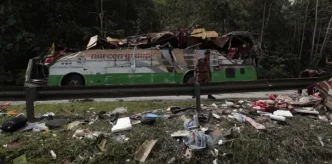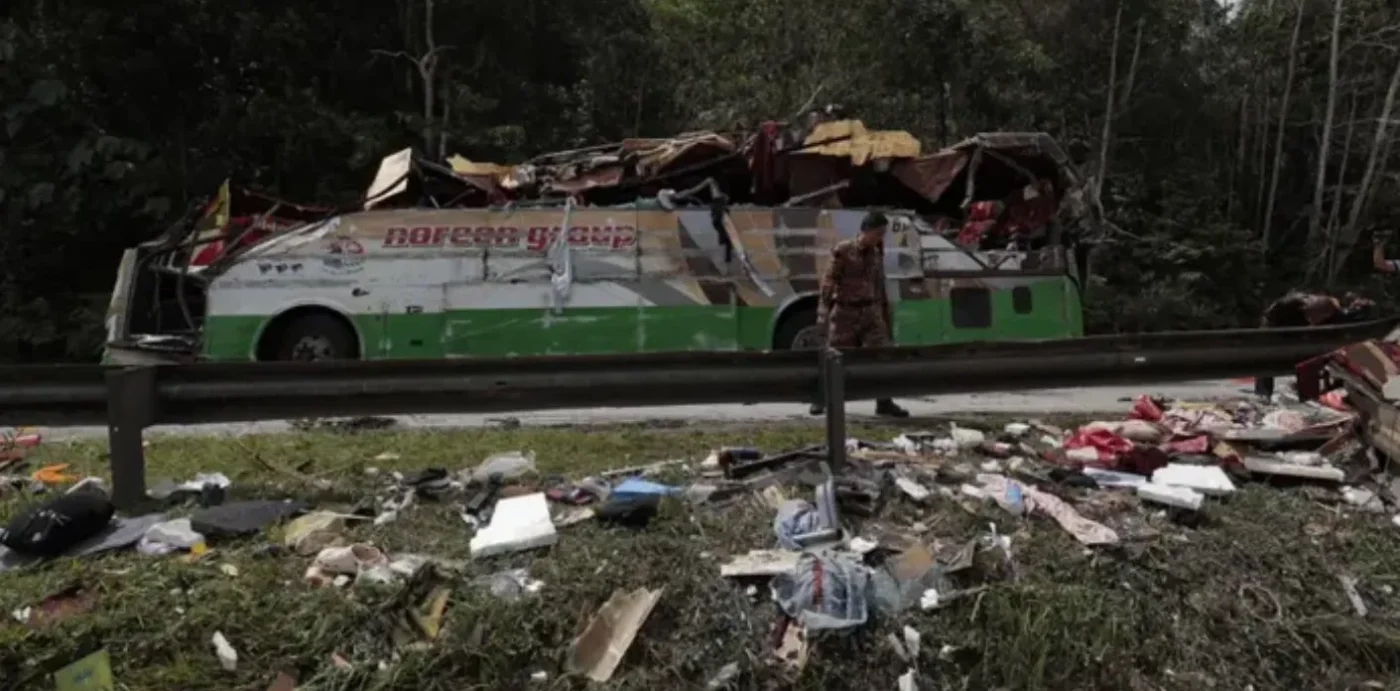A devastating bus crash on Malaysia’s East-West Highway has claimed the lives of 15 individuals, most of whom were students, in one of the deadliest road accidents in the country this year. The incident, which occurred on a notoriously treacherous stretch of road linking the east and west coasts of Peninsular Malaysia, has reignited urgent calls for improved road safety measures and stricter oversight of public transport operators. As families mourn their losses, questions are mounting over the systemic issues that may have contributed to this tragedy.
A Fatal Journey on a Perilous Road
The accident took place in the early hours of a foggy morning when a bus carrying students and several accompanying adults veered off the highway near Gerik, Perak, and plunged into a ravine. Authorities reported that the vehicle was en route to a school event on the east coast, a journey that required navigating the winding and often poorly maintained East-West Highway. Of the 15 fatalities, 12 were students aged between 13 and 17, while the remaining three were adults, including the bus driver. Several other passengers sustained critical injuries and were rushed to nearby hospitals.
Initial investigations suggest that a combination of factors may have led to the crash, including adverse weather conditions, possible driver fatigue, and the challenging terrain of the highway. Eyewitnesses described the road as “slippery and shrouded in mist” at the time of the accident, raising concerns about whether adequate precautions were taken. A spokesperson for the Perak police stated, “We are looking into all possible causes, including human error and the condition of the vehicle” during a press briefing.
Systemic Failures Under Scrutiny
The East-West Highway, while a vital artery connecting Malaysia’s less-developed east coast to the industrial west, has long been criticized for its dangerous design and lack of maintenance. Narrow lanes, sharp bends, and insufficient signage have made it a frequent site of accidents, particularly during the rainy season. Local residents and road safety advocates have repeatedly urged the government to invest in upgrades, including wider lanes, better lighting, and more frequent patrols to enforce speed limits.
Beyond infrastructure, the tragedy has also cast a spotlight on the regulation of public transport operators. Reports indicate that the bus involved in the crash was operated by a private company contracted by the school. Questions are now being raised about whether the vehicle met safety standards and if the driver was adequately trained for such a challenging route. “This is not just about one accident; it’s about a system that fails to prioritize safety” said a road safety activist based in Kuala Lumpur, who requested anonymity due to the sensitivity of the issue.
In response, Malaysia’s Transport Ministry has pledged to conduct a thorough investigation into the incident, with a focus on the bus operator’s compliance with safety regulations. The ministry issued a statement promising “swift action if negligence is found” but stopped short of committing to immediate highway improvements. Critics argue that such promises have been made before, often with little follow-through, leaving rural routes like the East-West Highway in a state of neglect.
A Community in Mourning
The loss of so many young lives has sent shockwaves through communities across Malaysia, particularly in the small towns from which the students hailed. Vigils have been held at schools and local mosques, with parents and classmates grappling with an unimaginable tragedy. Social media platforms have been flooded with messages of condolence, many using hashtags to demand accountability and safer roads. “These were children with dreams and futures ahead of them. How do we explain this to their families?” said a teacher who knew several of the victims.
The Malaysian government has announced financial assistance for the affected families, though many have expressed that no amount of compensation can fill the void left by their loved ones. Prime Minister Anwar Ibrahim extended his condolences in a public address, calling the incident “a heartbreaking reminder of the need to protect our children” and vowing to prevent similar tragedies. Yet, for many, these words ring hollow in the absence of concrete policy changes.
Road Safety in Malaysia: A Persistent Challenge
Malaysia has one of the highest road fatality rates in Southeast Asia, with thousands of deaths reported annually. According to the World Health Organization, the country records approximately 7,000 road deaths each year, a figure disproportionately high for its population size. Motorcycles account for the majority of these fatalities, but bus and lorry accidents, often involving long-distance travel on rural highways, remain a significant concern.
Experts point to a combination of factors contributing to this grim statistic: inadequate infrastructure, lax enforcement of traffic laws, and a culture of speeding and reckless driving. In rural areas, where public transport is often the only viable option for students and low-income families, the stakes are even higher. Buses, frequently old and poorly maintained, are packed with passengers on routes that are ill-equipped to handle heavy traffic or adverse weather.
The East-West Highway, in particular, has been flagged as a high-risk area for decades. Built in the 1970s to boost economic connectivity, the road was initially hailed as a feat of engineering. However, rapid urbanization and increased traffic have exposed its limitations. A 2019 study by a local university found that accident rates on the highway were nearly double the national average, with most incidents attributed to poor road conditions and driver error.
Calls for Reform Amid Grief
In the wake of this latest tragedy, advocacy groups are renewing their push for comprehensive road safety reforms. Proposals include mandatory safety audits for all public transport vehicles, stricter licensing requirements for drivers, and increased funding for rural infrastructure projects. Some have also suggested the introduction of speed governors on buses and lorries to prevent excessive speeding on dangerous routes.
Public sentiment, as reflected on platforms like X, shows growing frustration with government inaction. Many users have shared personal stories of near-misses on the East-West Highway, while others have criticized the authorities for prioritizing urban development over rural safety. “How many more lives must we lose before something is done?” asked one widely shared post.
Opposition lawmakers have seized on the incident to demand accountability, accusing the government of neglecting rural communities. During a recent parliamentary session, a member of the opposition coalition called for an independent inquiry into road safety policies, arguing that “reactive measures after tragedies are not enough.” The government, for its part, has promised to consider these demands, though no timeline for action has been provided.
Looking Ahead: Can Change Happen?
As investigations into the bus crash continue, the nation waits for answers that might bring some measure of closure to grieving families. Yet, beyond this single incident, the broader question remains: can Malaysia transform its approach to road safety to prevent future tragedies? The loss of 15 lives, most of them young students, has underscored the urgent need for systemic change, from better infrastructure to stricter oversight of transport operators.
For now, the East-West Highway stands as a somber reminder of the cost of inaction. As communities mourn and activists rally for reform, the hope is that this tragedy will serve as a catalyst for lasting improvements. Whether that hope becomes reality, however, depends on the willingness of those in power to act decisively in the face of a long-standing crisis.
















